brake fluid AUDI A5 COUPE 2014 Owners Manual
[x] Cancel search | Manufacturer: AUDI, Model Year: 2014, Model line: A5 COUPE, Model: AUDI A5 COUPE 2014Pages: 286, PDF Size: 70.99 MB
Page 17 of 286
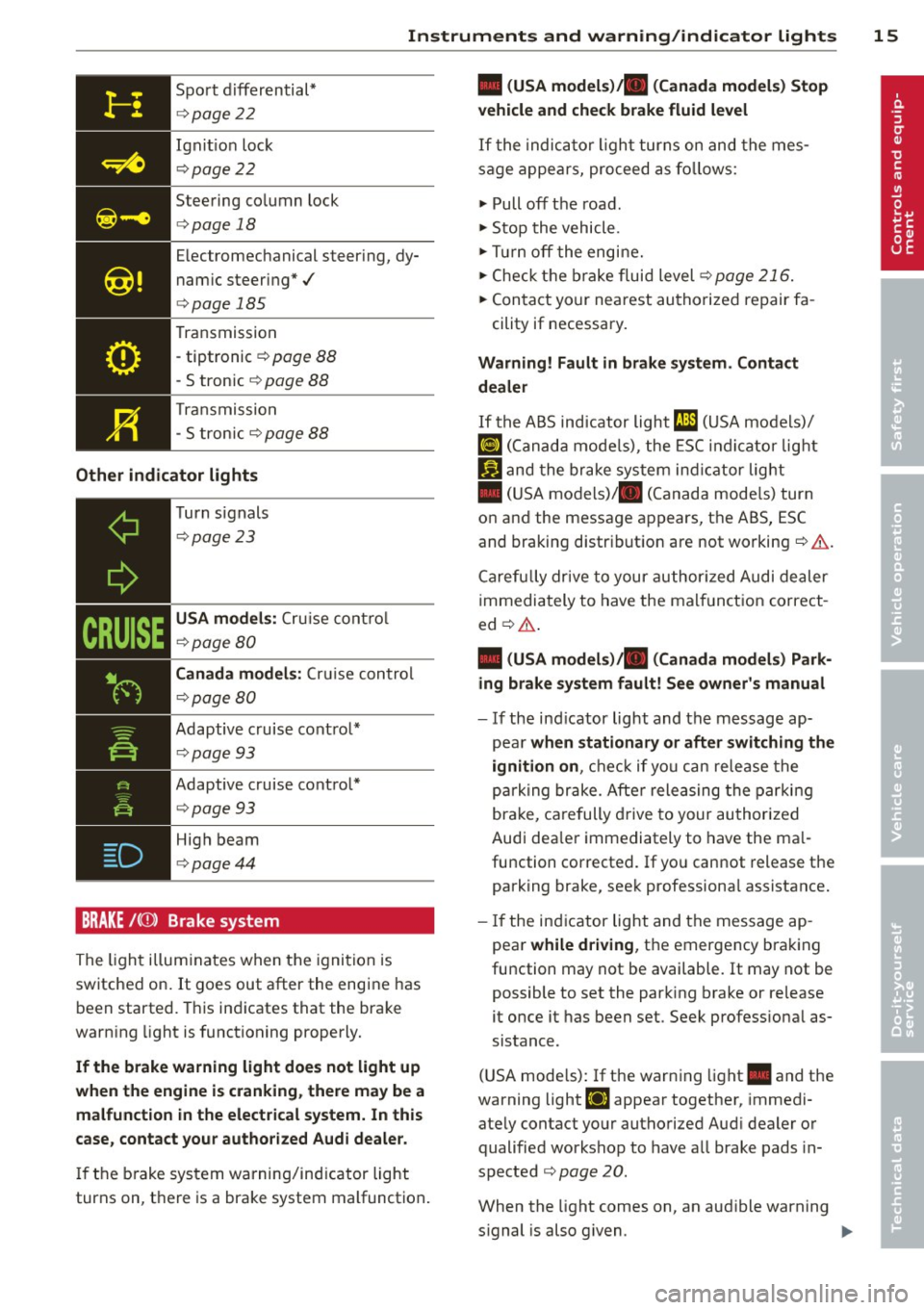
Instruments and warning/indicator lights 15
Sport d iffer ential*
¢ page 22
Ign it io n loc k
¢pag e 22
Steering co lumn lock
¢ pag e 18
Electromec hanical steer ing, dy
nam ic steer ing* ./
¢pag e 185
Transmission
- tiptronic ¢
page 88
- S tronic ¢ page 88
Tran smissio n
- S tron ic
¢ page 88
Other indicator lights
CRUISE
T urn signals
¢ page 23
USA models: Cruise con trol
¢page 80
Canada models: Cruise contro l
¢page 80
Adaptive c ruise cont ro l*
¢pag e 93
Adaptive cruise cont ro l*
¢ page 93
High beam
¢pag e44
BRAKE /((J) ) Brake system
The ligh t ill um inates when t he igni tion is
switche d on . It goes out after the engi ne has
been started. This in dicates that the bra ke
warn ing light is functioning properly.
If the brake warning light does not light up
when the engine is cranking , there may be a
malfunction in the electrical system. In this
case, contact your author ized Audi dealer.
If th e b rake system warning/ind icator light
turns on, t here is a brake system mal function .
• (USA models)/ . (Canada models) Stop
vehicle and check brake fluid level
If t he indic ator lig ht tu rns on and the m es
s a ge a ppe ars, pro ceed as fo llows:
"' Pull off t he roa d.
"' Sto p t he vehicle.
"' Turn off t he engi ne.
"' Check t he bra ke fluid level ¢
page 216.
"'Con tact your nea rest au thorized re pair fa -
cility if necessary .
Warning! Fault in brake system. Contact
dealer
If the ABS ind icator light CD (USA mode ls)/
lG) < C anad a mo de ls), the ESC in dicato r light
If.) and the bra ke sys tem in dicat or lig ht
• (US A mo dels)/ . (Canada mode ls) turn
o n and the messa ge appears, the ABS, ESC
and brakin g distr ibution are not workin g¢ &. .
C arefu lly dr ive to your author ized Audi de aler
immedi ately to have the malf unct ion correct
ed ¢&. .
• (USA models)/ . (Canada models) Park
ing brake system fault! See owner' s manual
- If the in dicator light and the m essage ap -
pe ar
when stationary or after switching the
ignition on ,
check if yo u can re lease the
p arki ng br ake. Afte r relea sing the park ing
bra ke, ca re fully drive to your au thori zed
A udi dea le r i mmediately to have the ma l
fu nction corrected . If yo u cannot release t he
parking brake, see k professiona l assistance .
- If the in dicator light and the message ap
pea r
while driving , th e e mergency bra king
fu nction may not be available. It may not be
possible to set the par king brake or re lease
it once it has been set. Seek profess iona l as
sistance.
( U SA mode ls) : If th e warn ing lig ht. and the
warning light
fi] appear togethe r, immedi
ate ly contact yo ur aut horized Aud i dealer o r
qualified wo rks hop to have a ll brake pads in
s p ected
¢ page 20.
When the light comes on, an aud ible warning
s ignal is also g iven.
Page 18 of 286
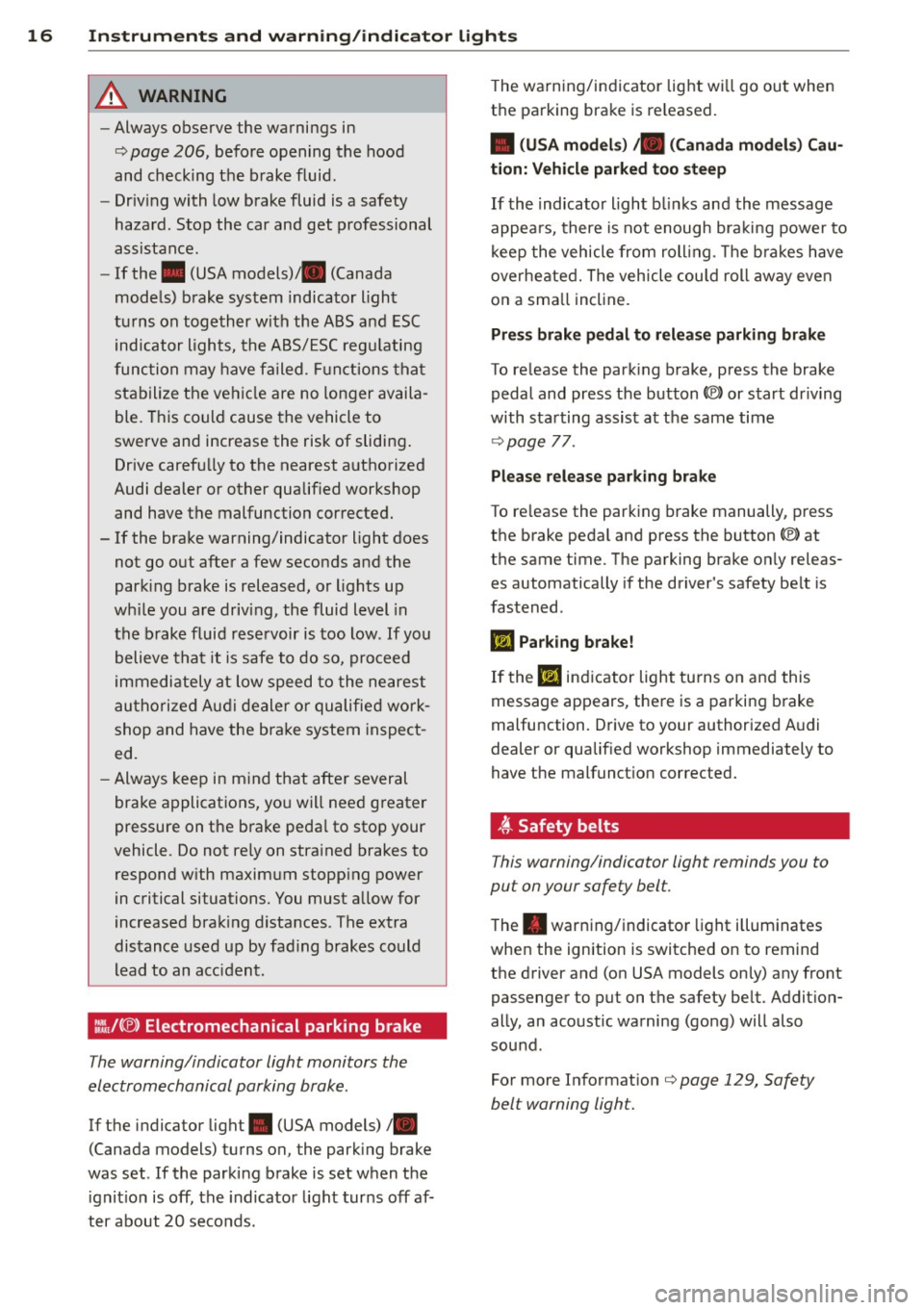
16 Instrum ent s and w arn ing /indic ato r light s
A WARNING
-Always observe the warnings in
i=> page 206, before opening the hood
and checking the brake fluid.
- Driv ing with low brake fluid is a safety
hazard. Stop the car and get professional
assistance.
- If the . (USA
models) ;II (Canada
models) brake system indicator l ight
turns on together with the ABS and ESC indicator lights, the ABS/ESC regu lating
function may have failed. F unctions that
stabilize the vehicle are no longer availa
ble. This could cause the vehicle to
swerve and increase the risk of sliding .
Drive carefu lly to the nearest authorized
Audi dealer or other qualified workshop
and have the malfunction corrected.
- If the brake warning/indicator light does not go out after a few seconds and the
park ing brake is released, or lights up
wh ile you are driving, the fluid level in
the brake fluid reservoir is too low . If you
believe tha t it is safe to do so, proceed
immediately at low speed to the nearest
authorized Audi dealer or qualified work shop and have the bra ke system inspect
ed.
- Always keep in m ind that after several
brake applications, yo u will need greater
pressure on the b rake peda l to stop your
vehicle. Do not re ly on strained brakes to
respond w ith maximum stopp ing power
in critical situations. You must allow for
increased brak ing distances . The extra
distance used up by fad ing brakes could
lead to an acc ident.
:fil.J(® ) Electromechanical parking brake
The warning/indicator light monitors the
electromechanical parking brake .
If the indicator light. (USA models)/ .
(Canada models) turns on, the park ing brake
was set . If the parking brake is set when the
ignit ion is off, the indicator light turns off af
ter about 20 seconds. T
he warn ing/indicator light wi ll go out when
the parking brake is re leased.
• (USA model s) /. (Canada mod els) Cau
ti on: Vehicle parke d too steep
If the indicato r light b links and the message
appea rs, there is not enough bra king power to
k eep the vehicle from roll ing . T he brakes have
overheated. The veh icle cou ld roll away even
on a sma ll incline.
Pre ss brak e pedal to rel eas e parking brake
To re lease the park ing brake, press the brake
pedal and press the button(®) or start driving
with sta rting assist at t he same time
i=> page 77.
Pl ease r elea se parking brake
To re lease the park ing brake manually, p ress
the brake pedal and press the button®) at
the same time. The parking brake on ly releas
es automatically if the driver's safety be lt is
fastened.
Iii Parking brake!
If t he Iii ind icator light tu rns o n and this
message appears, there is a parking brake
malfunction. Drive to your authorized A udi
dealer or qualified workshop immediately to
have the malfunct ion corrected.
~ Safety belts
This warning/indicator light reminds you to
put on your safety belt.
T he . warning/ indicator light illuminates
when the ignition is switched on to remind
the driver and (on USA models only) any front
passenger to put on the safety be lt. Addit ion
ally, an acoustic warning (gong) will also
sound.
For more Informat ion
c:> page 129, Safety
belt warning light.
Page 186 of 286
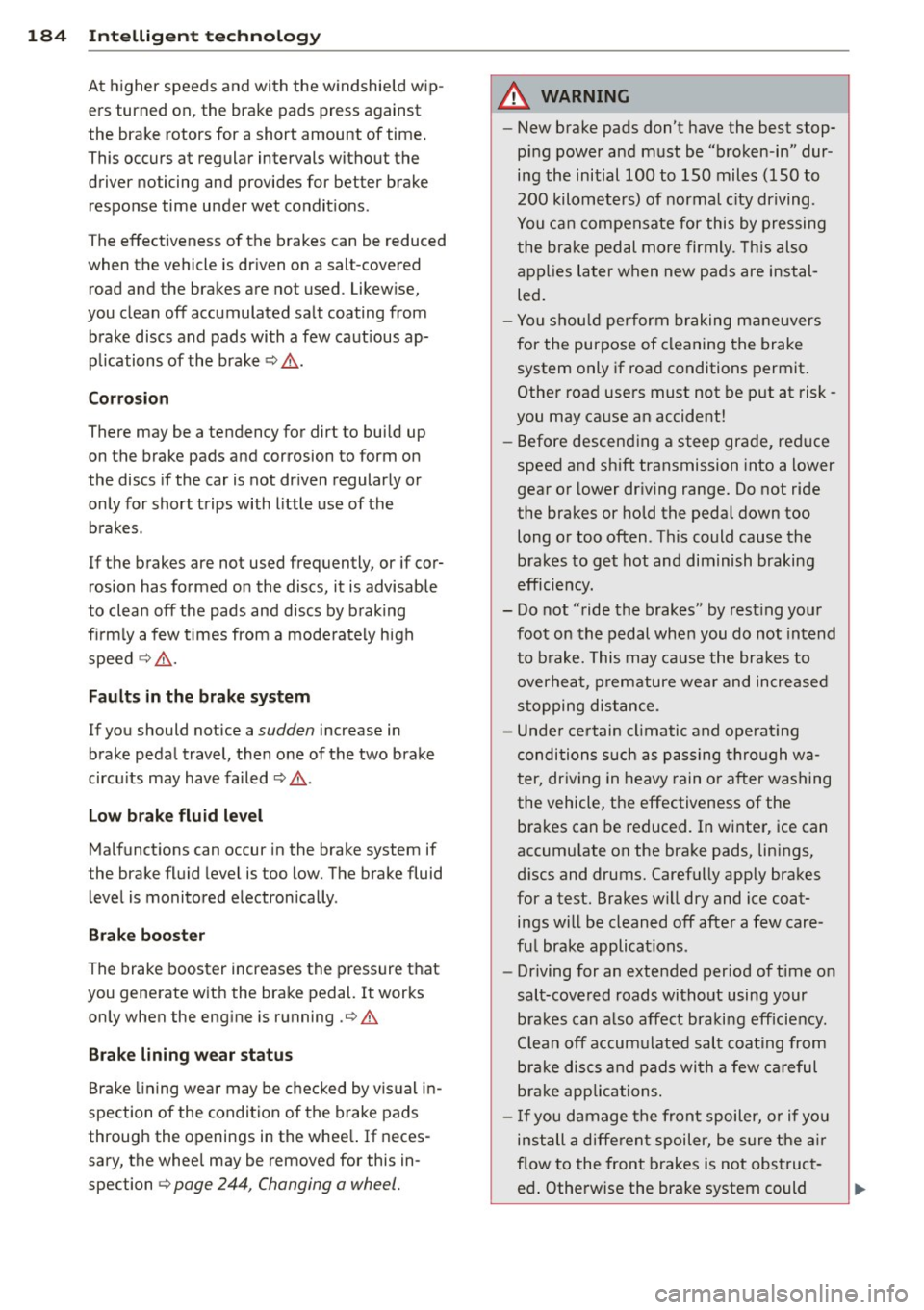
184 Intelligent technology
At higher speeds and with the windshield wip
ers turned on, the brake pads press against
the brake rotors for a short amount of time .
This occurs at regular intervals without the
driver noticing and provides for better brake
response time under wet condit ions .
The effectiveness of the brakes can be reduced
when the vehicle is dr iven on a salt-covered
road and the brakes are not used . Likew ise,
you clean
off accumulated sa lt coating from
brake discs and pads with a few caut ious ap
plications of the brake¢&. .
Cor ro sion
There may be a tendency for dirt to build up
on the brake pads and corrosion to form on
the discs if the car is not dr iven regularly or
only for short trips with l ittle use of the
brakes .
If the brakes are not used frequently , or if cor
rosion has formed on the discs, it is advisable
to clean
off the pads and discs by brak ing
firm ly a few times from a moderately high
speed ¢,& .
Fa ults in the brake system
If you should notice a sudden increase in
brake pedal travel, then one of the two brake
circu its may have failed¢&. .
Low brake fluid le vel
Malfunct ions can occur in the brake system if
the brake fluid level is too low. The brake fluid
leve l is monitored electronically .
Brake boost er
The brake booster increases the pressure that
you generate w ith the brake pedal. It works
only when the eng ine is running .¢ &.
Brake lining w ear status
Brake lining wea r may be checked by vis ual in
spection of the condition of the brake pads
through the openings in the whee l. If neces
sary, the whee l may be removed for this in
spection
¢ page 244, Changing a wheel.
_& WARNING
-New brake pads don't have the best stop
ping power and must be "broken -in" dur
ing the initial 100 to 150 miles (150 to
200 kilometers) of normal c ity driving .
You can compensate for this by pressing the brake pedal more firmly . T his also
applies later when new pads are instal led.
- You shou ld perform braking maneuvers
for the purpose of cleaning the brake system only if road conditions permit .
Othe r road users must not be put at risk -
you may ca use an accident!
- Before descend ing a steep grade, reduce
speed and sh ift transmission into a lower
gear or lower dr iving range. Do not ride
the brakes or hold the pedal down too
long o r too often . This could cause the
brakes to get hot and diminish braking
efficiency.
- Do not "ride the brakes" by rest ing you r
foot on the pedal when you do not intend
to b rake. This may cause the brakes to
overheat, p remature wear and increased
s topping distance.
- Unde r ce rtain cl imatic and ope rat ing
conditions such as passing thro ugh wa
ter, dr iving in heavy rain o r after washing
the vehicle, the effectiveness of the brakes can be reduced. In winter, ice can
accumu late on the brake pads, linings,
d iscs and drums. Carefully apply brakes
for a test. Brakes will dry and ice coat
ings will be cleaned
off after a few care
fu l brake applicat ions .
- Driving for an extended period of t ime on
salt-covered roads without using your brakes can a lso affect braking efficiency .
Clean
off accumulated salt coating from
b rake discs and pads wi th a few ca reful
b rake applications.
- I f you damage the front spoiler, or if you
install a different spoiler, be sure the a ir
flow to the front brakes is not obstruct-
ed . Otherwise the brake system could
~
Page 208 of 286
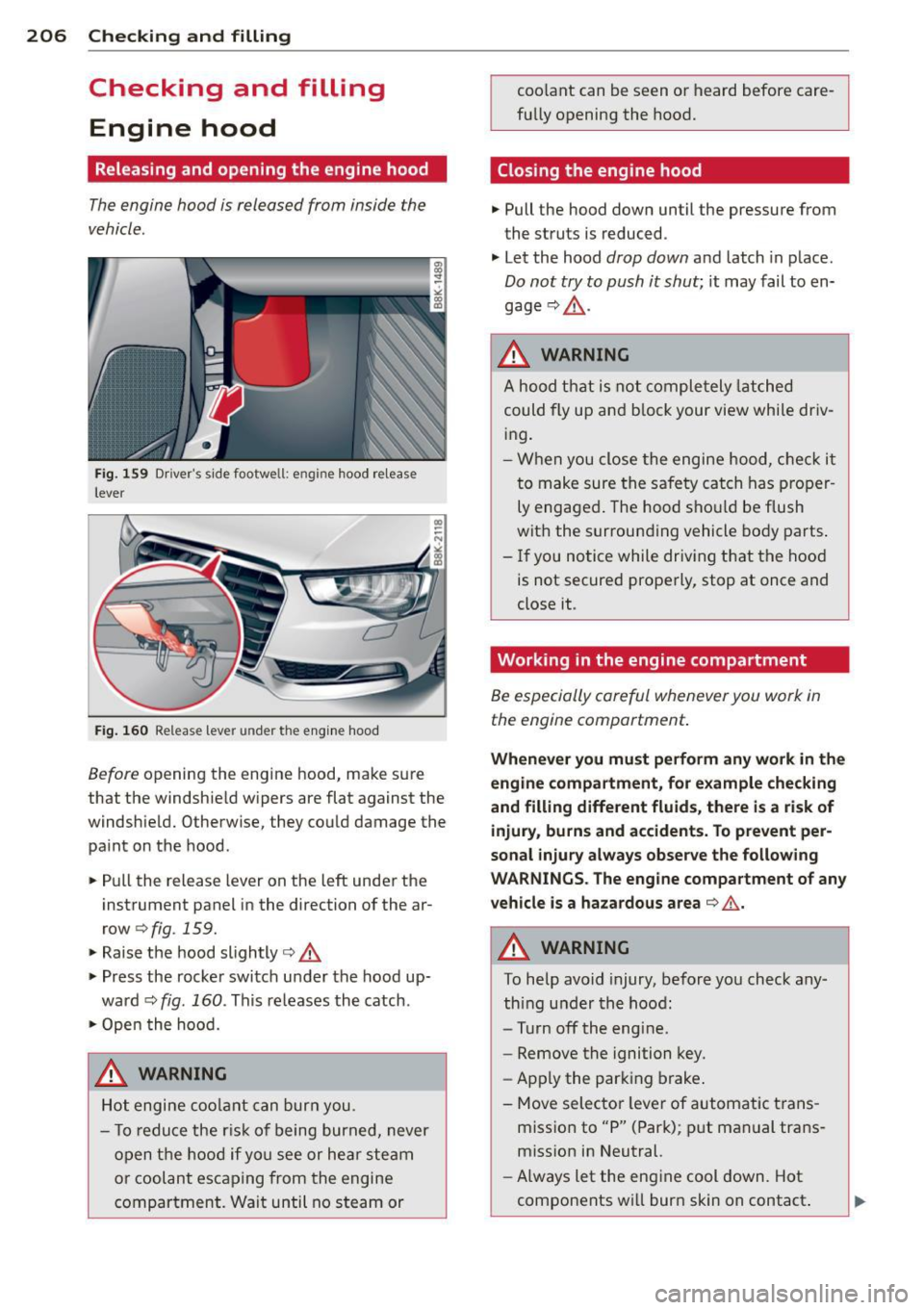
206 Checking and filling
Checking and filling
Engine hood
Releasing and opening the engine hood
The engine hood is released from inside the
vehicle .
Fig . 159 D river' s side footwe ll: e ngin e hood re lease
lever
F ig. 160 Re lease lever u nde r the eng ine hood
Before openin g the engine hood, ma ke s ure
that the windshie ld w ipers are flat against the
windshield. Otherwise, they co uld damage the
pa int on the hoo d.
... Pull the release lever on the left unde r the
inst rument panel in the direction of the ar
row
c;, fig . 159.
... Raise the hood slightly r::;, .&,
... Press the rocke r swi tch u nder the hood up
ward
c;, fig . 160 . Th is re leases the catch .
... Ope n t he hood.
A WARNING
Hot engi ne co olan t ca n bur n you.
- T o redu ce the r is k o f being burned, never
op en t he ho od if yo u see or hea r steam
or cool an t esc aping from the en gine
c ompartment. Wait unti l no steam or co
olant can be seen or heard before care
fu lly opening the hood.
Closing the engine hood
... Pull the hood down until the pressure from
the struts is reduced .
... Le t the hood
drop down and latch in p lace.
Do not try to push it shut; it may fail to en
gage
r::;, .&, .
A WARNING
-
A ho od th at is not co mpletely latched
could fly u p an d block your view while driv
in g.
- Wh en you close the engi ne ho od, ch ec k it
t o make sure the sa fe ty ca tch has pro pe r
ly engaged . The hood s hould be flush
wit h the surroun ding vehicle body pa rts .
-If you notice while driv in g that t he hood
is not secured prope rly, sto p at once and
close it.
Working in the engine compartment
Be especially ca reful whenever you work in
the engine compartment.
Whenever you must perform any work in the
engine compartment, for example checking
and filling different fluid s, there is a ri sk of
injury , burns and accidents . To prevent per
sonal injury always observe the following
WARNINGS. The engine compartment of any
vehicle is a hazardous area
r::;, ,&. .
A WARNING
-To help avo id injury, before yo u check any-
thing unde r the hoo d:
- Turn off the eng ine.
- Remove the ignition key.
- Ap ply the park ing brake .
- Move selector leve r of automatic t rans -
miss io n to "P" (Par k); pu t man ual trans
miss ion in Neu tral.
- Al ways let the eng ine cool down. Hot
components wi ll burn skin on contact .
Page 209 of 286
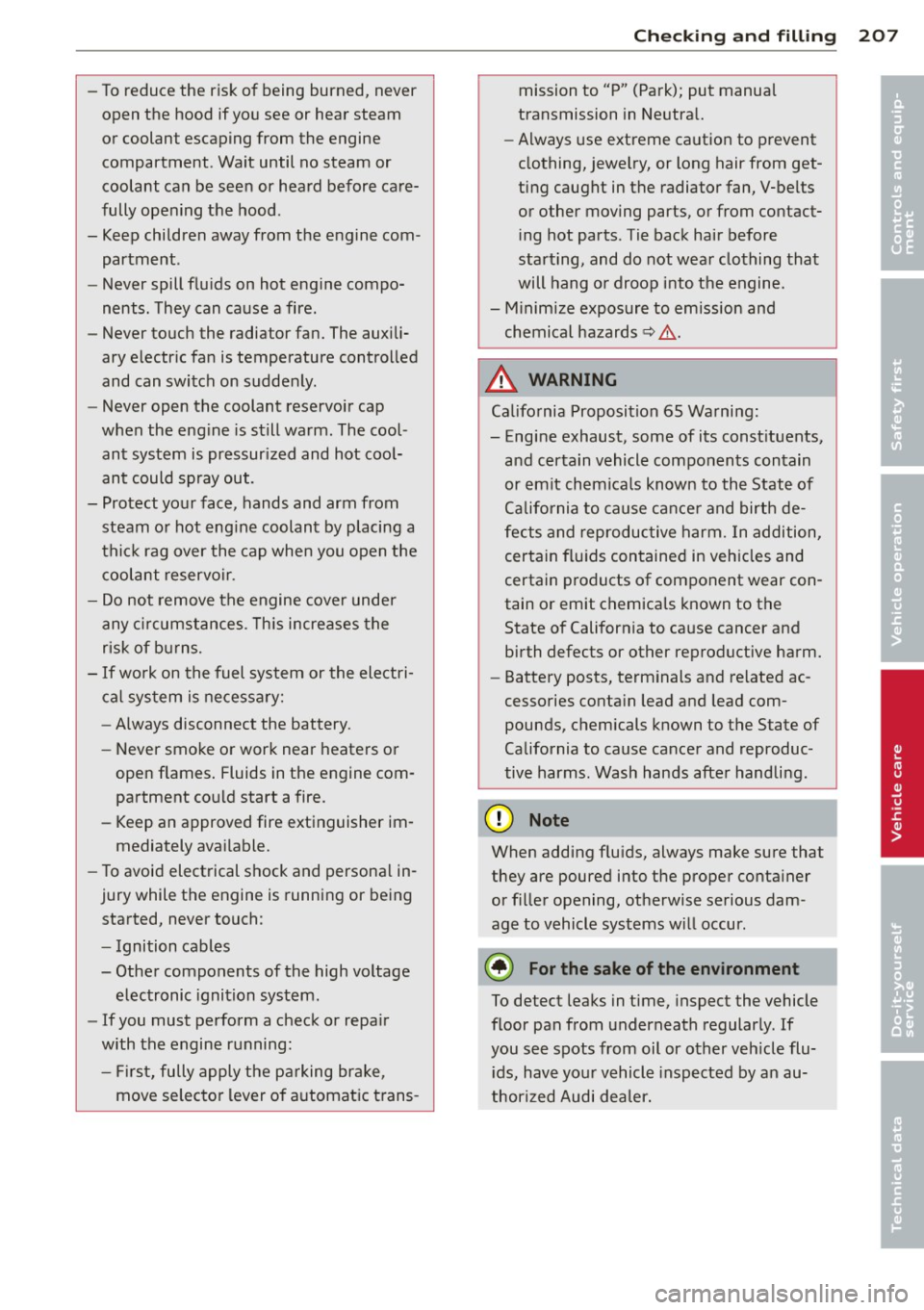
-To reduce the r isk of being burned, never
open the hood if you see or hear steam
or coolant escaping from the engine
compartment . Wait until no steam or
coolant can be seen or heard before ca re
fully opening the hood .
- Keep children away from the engine com
partment.
- Never spill flu ids on hot engine compo
nents. They can cause a fire .
- Never touch the radiator fan. The aux ili
ary e lectr ic fan is temperature controlled
and can switch on suddenly .
- Never open the coolant reservoir cap
when the eng ine is still warm . The cool
ant system is pressur ized and hot coo l
ant could spray out.
- Protect your face, hands and arm from
steam or hot eng ine coolant by placing a
thic k rag over the cap when you open the
coolant reservoir.
- Do not remove the engine cover under
any c ircumstances. Th is increases the
risk of bu rns.
- If wo rk on the fuel system or the electri
cal sys tem is ne cessary:
- Always disconnect the battery.
- Never smoke or work near heaters or
open flames . Fluids in the engine com
partment co uld start a fire.
- Keep an approved fire extinguisher im
mediately ava ilable.
- To avoid electrical s hock and persona l in
jury while the engine is running or being
started, never touch:
- Ignition cables
- Other components of the high voltage
electronic ignition system.
- If you must perform a check or repa ir
with the engine running:
- Fir st, fully apply the parking brake,
move se lector lever of a utomatic trans-
Checkin g and fillin g 207
mission to "P" (Park); put manual
transmission in Neutral.
- Always use extreme caution to prevent
clothing, jewe lry, or long hair from get
ting caught in the radiator fan, V-be lts
or other moving parts, or from contact i ng hot parts . Tie back hair before
starting, and do not wear clothing that
will hang o r droop into the engine .
- Minimize exposure to emission and
chemical hazards~&. .
A WARNING
California Proposition 65 Warning:
- Engine exhaust, some of its const ituents,
a nd certain vehicle components contain
or emit chemicals known to the State of
Ca lifornia to cause cance r and birth de
fects and reproductive harm. In addition, certain fl uids contained in veh icles and
certain products of component wear con
tain or emit chemica ls known to the
State of California to cause cancer and
birth defects or other reproductive harm.
- Battery posts, terminals and related ac
cessories conta in lead and lead com
pounds, chemicals known to the State of
California to cause cancer and reproduc
tive harms. Wash hands afte r handling.
Q) Note
When adding f lu ids, always make sure that
they are poured into the proper conta iner
or f iller opening, otherwise serious dam
age to vehicle systems w ill occur .
@ For the sake of the environment
To detect leaks in time, inspect the vehicle
floor pan from underneath regular ly . If
you see spots from oil or other veh icle flu
i ds, have your vehicle inspected by an au
thorized Audi dealer. •
•
Page 218 of 286
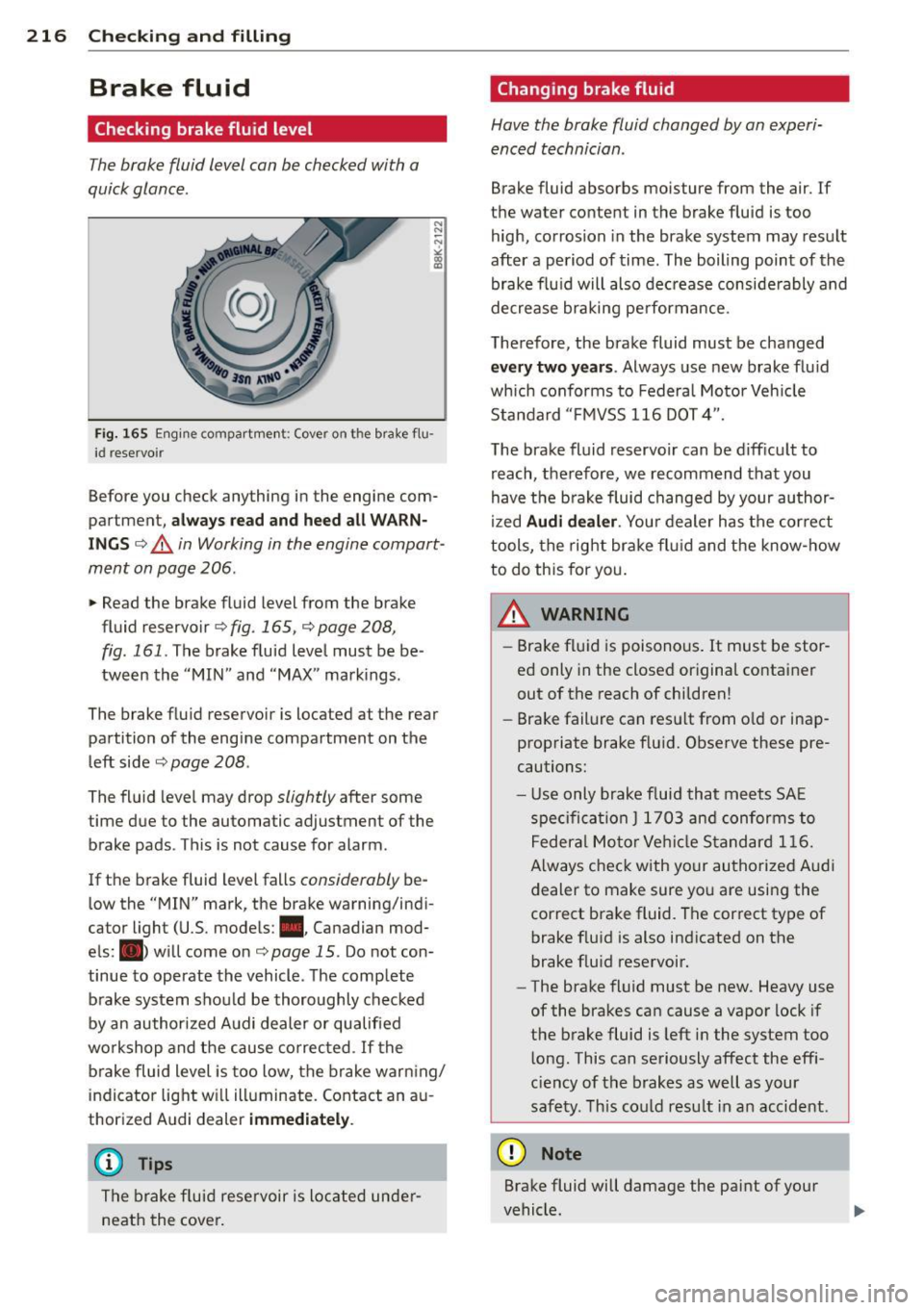
216 Checking and filling
Brake fluid
Checking brake fluid level
The brake fluid level can be checked with a
quick glance .
N N ~ N
" (X) (0
Fig. 165 Engine compartme nt: Cover on the brake flu ·
id reservo ir
Before you check anything in the engine com
partment,
always read and heed all WARN·
INGS ¢ .&._ in Working in the engine compart
ment on page 206 .
.. Read the brake fluid level from the brake
fluid reservoir ¢
fig. 165, ¢ page 208,
fig. 161.
The brake fluid level must be be ·
tween the "MIN" and
"MAX" markings.
The brake fluid reservoir is located at the rear
partition of the engine compartment on the
left side ¢
page 208 .
The fluid level may drop slightly after some
time due to the automatic adjustment of the
brake pads . This is not cause for alarm.
If the brake fluid level falls
considerably be
low the "MIN" mark, the brake warning/indi
cator light (U.S. models: ., Canadian mod
els: .) will come on¢
page 15. Do not con
tinue to operate the vehicle . The complete
brake system should be thoroughly checked
by an authorized Audi dealer or qualified
workshop and the cause corrected.
If the
brake fluid level is too low, the brake warning/
indicator light will illuminate. Contact an au
thorized Audi dealer
immediately .
@ Tips
The brake fluid reservoir is located under
neath the cover.
Changing brake fluid
Have the brake fluid changed by an experi
enced technician .
Brake fluid absorbs moisture from the air. If
t he water content in the brake fluid is too
high, corrosion in the brake system may result
after a period of time . The boiling point of the
brake fluid will also decrease considerably and
decrease braking performance.
Therefore, the brake fluid must be changed
every two years . Always use new brake fluid
which conforms to Federal Motor Vehicle
Standard "FMVSS 116 DOT 4".
The brake fluid reservoir can be difficult to reach, therefore, we recommend that you
have the brake fluid changed by your author
ized
Audi dealer. Your dealer has the correct
tools, the right brake fluid and the know-how
to do this for you .
A WARNING
- Brake fluid is poisonous. It must be stor
ed only in the closed original container
out of the reach of children!
- Brake failure can result from old or inap
propriate brake fluid. Observe these pre
cautions:
- Use only brake fluid that meets SAE
specification
J 1703 and conforms to
Federal Motor Vehicle Standard 116.
Always check with your authorized Audi
dealer to make sure you are using the
correct brake fluid. The correct type of
brake fluid is also indicated on the
brake fluid reservoir.
- The brake fluid must be new. Heavy use
of the brakes can cause a vapor lock if
the brake fluid is left in the system too
long . This can seriously affect the effi
ciency of the brakes as well as your
safety. This could result in an accident.
(D Note
Brake fluid will damage the paint of your
vehicle.
Page 219 of 286
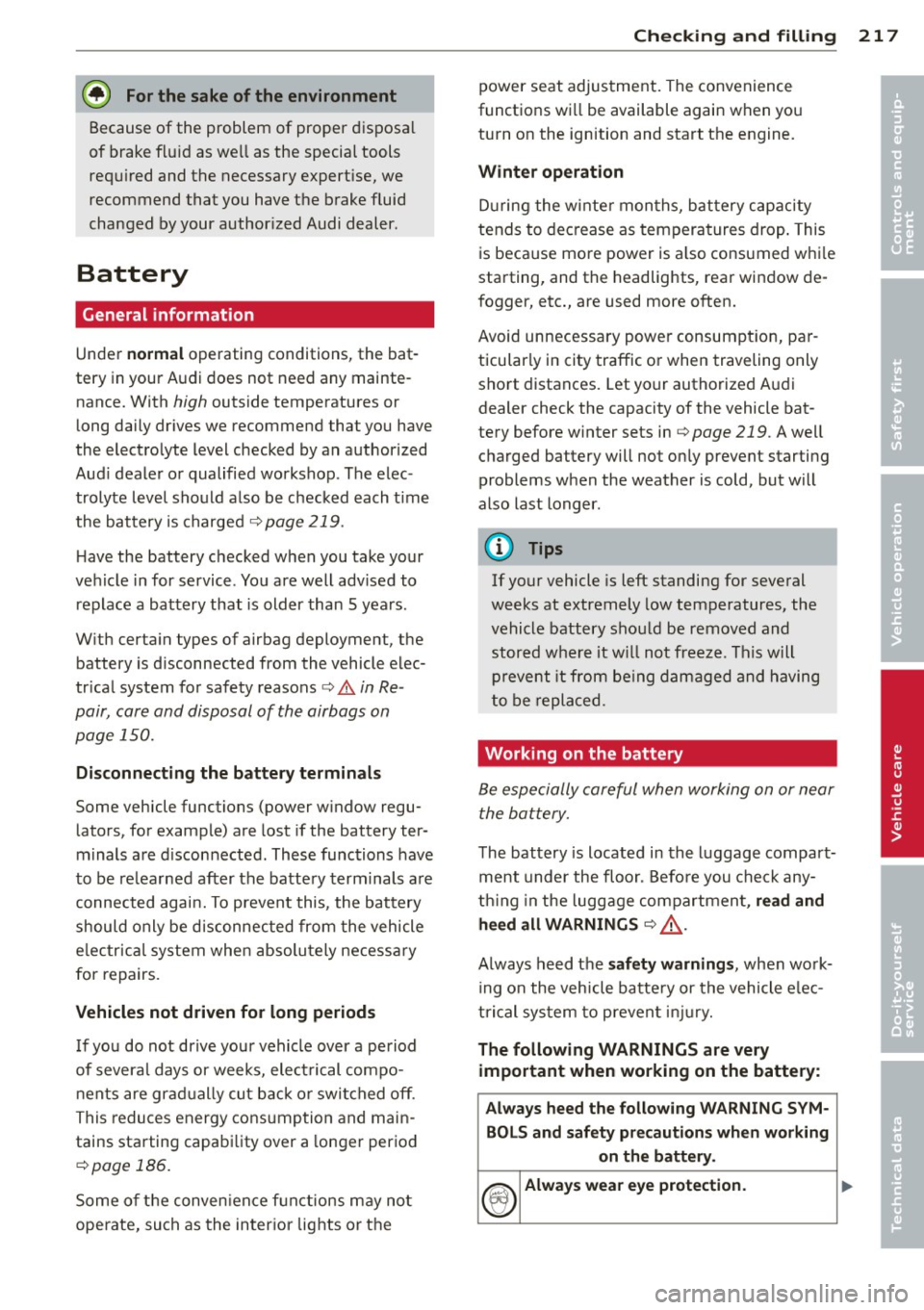
@ For the sake of the environment
Because of the pr oblem of proper d isposa l
of brake flu id as we ll as the special tools
requ ired and the necessary expert ise, we
recommend that you have the brake fluid
changed by your author ized Audi dealer .
Battery
General information
Under normal operating conditions, the bat
tery in your Audi does not need any mainte
nance. With
high outside temperatures or
long daily dr ives we recommend that you have
the electro lyte level checked by an authorized
Aud i dealer or qualified workshop . The elec
trolyte leve l should also be checked each time
the battery is charged ¢
page 219.
Have the battery checked when you take your
ve hicle in for service . Yo u are well adv ised to
replace a battery that is older than 5 yea rs .
W ith certa in types of a irbag deployment, t he
b attery is d isconnected from the vehicle elec
tr ica l system for safety reasons¢.&.
in Re
pair, care and disposal of the airbags on
page 150.
Disconnecting the battery terminals
Some vehicle functions (power w indow regu
lators , for example) are lost if the battery ter
m inals a re d isconnected. These func tions have
to be re lea rned after the batte ry term inals a re
connected agai n. T o prevent this , the bat tery
should only be d isconnec ted from the vehicle
e lec tric al system when absolu tely necessa ry
for repairs .
Vehicles not driven for long periods
If you do not drive you r vehicle over a period
of severa l days or weeks, elec trical compo
nen ts are gr adually cut b ack o r swi tched off .
This redu ces energy cons umption and main
tains starting capab ility over a longer per io d
¢ page 186.
Some o f the conven ience f unctions m ay not
ope rate, su ch as the in ter ior lig hts or t he
Checkin g and fillin g 217
power seat adjus tment. The convenience
funct io ns w ill be available again when yo u
turn o n the ign ition and start the engine.
Winter operation
D ur ing the w inte r mon ths, bat tery capa city
tends to dec rease as tempera tures drop . This
is beca use more power is a lso consumed wh ile
starting, and the headlights, rear window de
fogge r, etc., are used more often.
Avoid unnecessary powe r consumpt ion, pa r
ticular ly in city traffic or when traveling only
sho rt distances. Let yo ur authorized A udi
dealer check the capacity of the vehicle bat
tery before w inter sets in
¢ page 219. A well
charged battery will no t on ly prevent star tin g
problems w hen the weather is cold, but w ill
also last longer .
@ Tips
If your vehicle is left standing for seve ral
weeks at extremely low temperatures, the
vehicle battery s hou ld be removed and
stored where it will not freeze . This will
p revent it from be ing damaged and having
to be repla ced .
Working on the battery
Be especially careful when working on or near
the bat tery.
The battery is located in the luggage compar t
ment under the floor . B efo re you che ck any
thi ng in the luggage compartment,
read and
heed all WARNINGS
¢ ,&. .
Always heed the safety warnings , when work
i ng on the veh icle batte ry or t he vehicle e lec
t rical sys tem to p reven t inju ry.
The following WARNINGS are very
important when working on the battery:
Always heed the following WARNING SYM· BO LS and safety precautions when working
on the battery .
®
Always wear eye protection.
•
•
Page 235 of 286
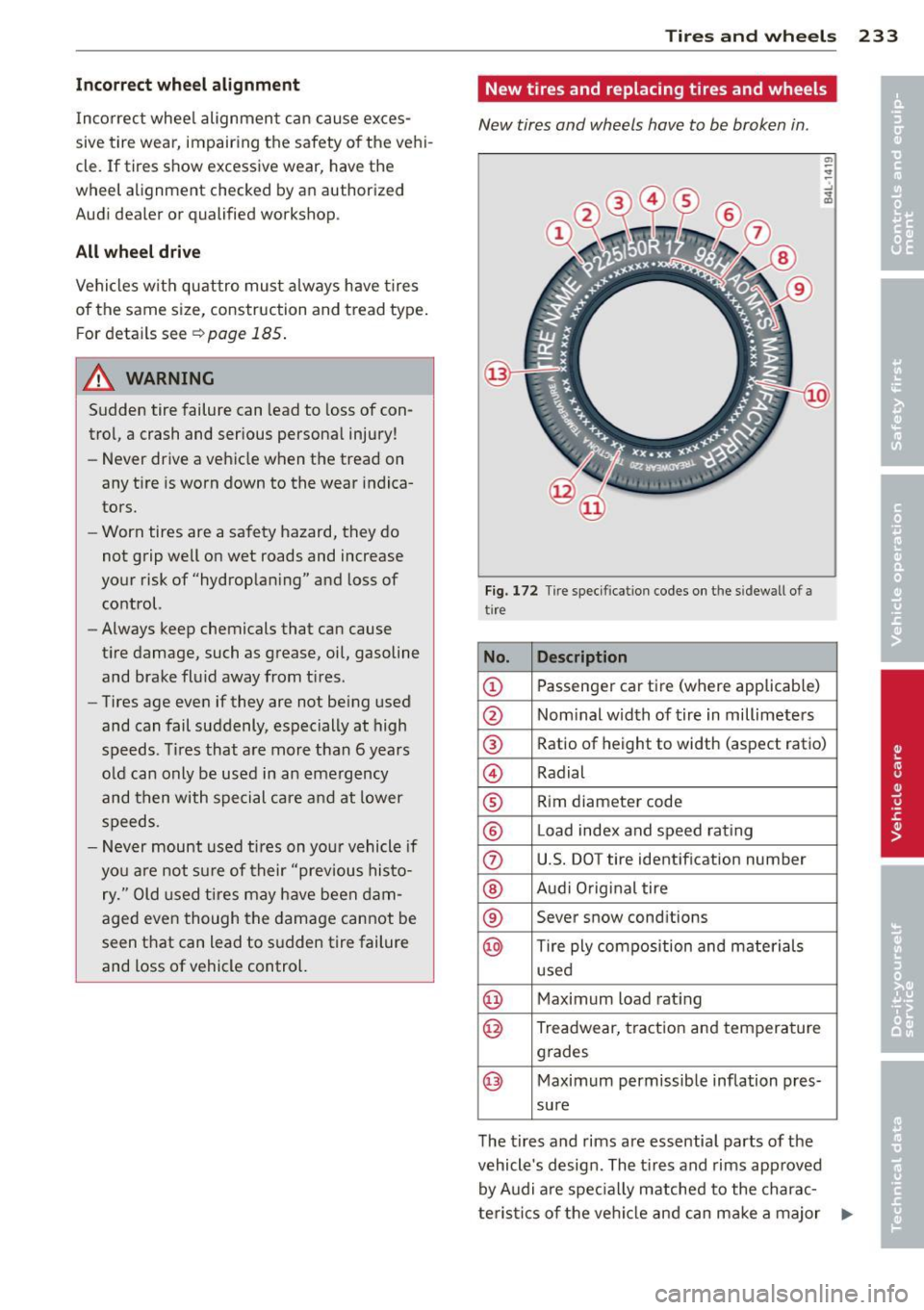
Incorrect wheel alignment
Incorrect wheel alignment can cause exces
sive tire wear, impairing the safety of the vehi
cle. If tires show excessive wear, have the
wheel alignment checked by an authorized
Audi dealer or qualified workshop .
All wheel drive
Vehicles with quattro must always have tires
of the same size, construction and tread type.
For details see
~page 185 .
.8_ WARNING
Sudden tire failure can lead to loss of con
trol, a crash and serious personal injury!
- Never drive a vehicle when the tread on
any tire is worn down to the wear indica
tors.
- Worn tires are a safety hazard, they do
not grip well on wet roads and increase
your risk of "hydroplaning" and toss of
control.
- Always keep chemicals that can cause
tire damage, such as grease, oil, gasoline
and brake fluid away from tires.
- Tires age even if they are not being used
and can fail suddenly, especially at high
speeds. Tires that are more than 6 years
old can only be used in an emergency
and then with special care and at lower
speeds .
- Never mount used tires on your vehicle if
you are not sure of their "previous histo
ry." Old used tires may have been dam
aged even though the damage cannot be
seen that can lead to sudden tire failure
and loss of vehicle control.
Tires and wheels 233
New tires and replacing tires and wheels
New tires and wheels have to be broken in .
Fig. 172 Tir e specificat ion codes on t he s idewall o f a
tire
No. Description
@ Passenger car tire (where applicable)
@ Nominal width of tire in millimeters
@ Ratio of height to width (aspect ratio)
© Radial
® Rim diameter code
® Load index and speed rating
0 U.S. DOT tire identification number
® Audi Original tire
® Sever snow conditions
@ Tire ply composition and materials
used
@ Maximum load rating
@ Treadwear, traction and temperature
grades
@ Maximum permissible inflation pres-
sure
The tires and rims are essential parts of the
vehicle's design . The tires and rims approved
by Audi are specialty matched to the charac
teristics of the vehicle and can make a major .,.
Page 268 of 286
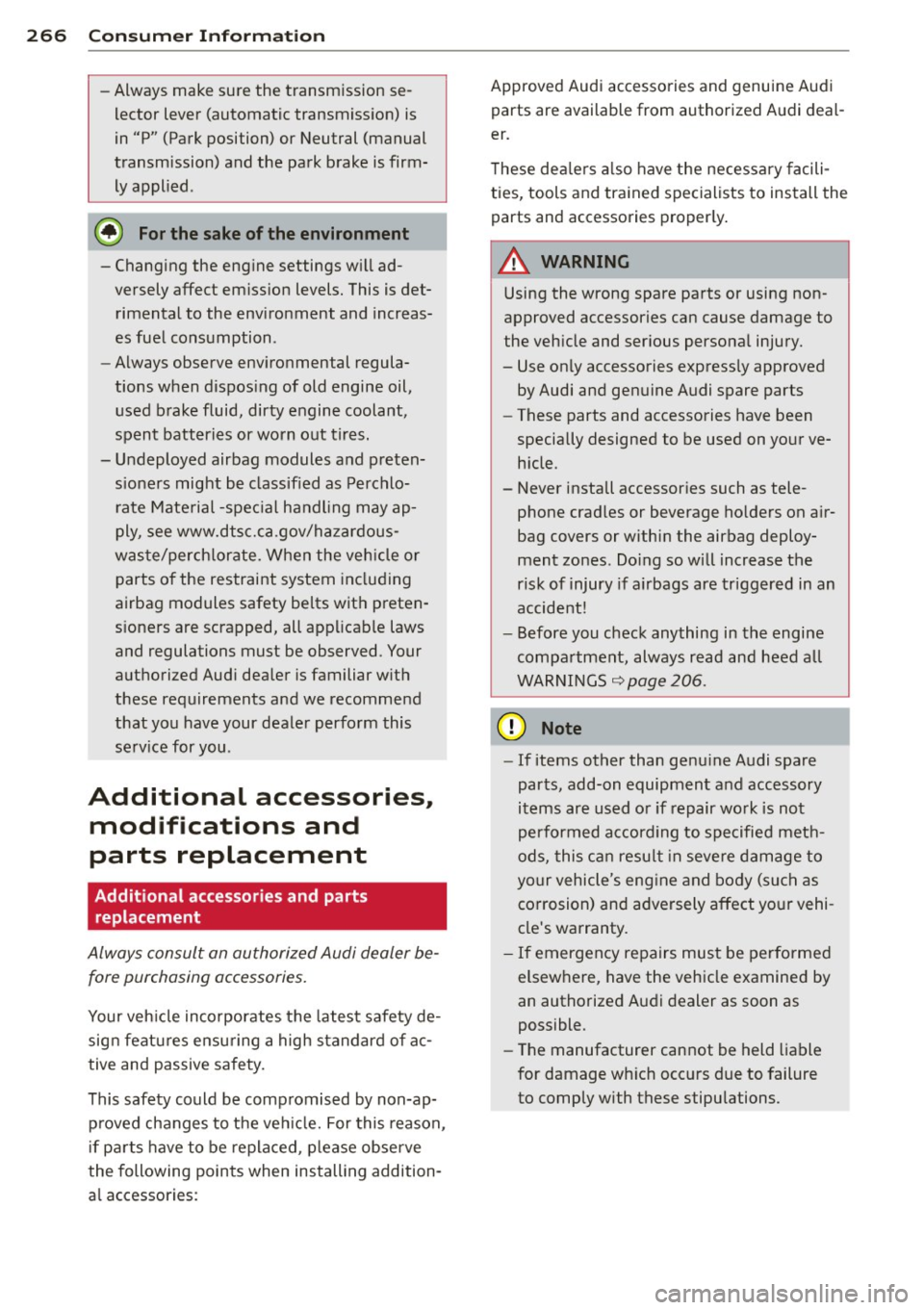
26 6 Con sum er Inf ormation
-Always make sure the transmission se
lector lever (automatic transmiss ion) is
in "P" (Park position) or Neutral (manual
transmission) and the park brake is firm
ly applied.
@) For the s ake of the environment
-Changing the engine settings will ad
versely affect emission levels. This is det
rimental to the environment and increas
es fuel consumption .
- Always observe environmental regula
tions when disposing of old engine oil,
used brake fluid, dirty engine coolant,
spent batteries or worn out tires.
- Undeployed airbag modules and preten
s ioners might be classified as Perchlo
rate Material -spec ial handling may ap
ply, see www.dtsc.ca .gov/hazardous
waste/perch lorate. When the veh icle or
parts of the restraint system including
airbag modules safety belts with preten
sioners are scrapped, all app licable laws
and regulations must be observed . Your
authorized Audi dealer is familiar with
these requirements and we recommend
that you have your dealer perform this
serv ice for you .
Additional accessories,
modifications and
parts replacement
Additional accessories and parts
replacement
Always consult on authorized Audi dealer be
fore purchasing accessories.
Your veh icle inco rporates the latest safety de
sign featu res ensuring a high standard of ac
tive and passive safety.
This safety could be compromised by non-ap
proved changes to the veh icle. For this reason ,
if pa rts have to be replaced , please observe
the following points when installing addition
a l accessories: Approved Audi accessories and genuine Audi
parts are available from authorized Audi deal
er.
T hese dea lers a lso have the necessary facili
ties, tools and trained specialists to install the parts and acc essories proper ly.
A WARNING
-Using the wrong spare parts or using non-
approved accessories can cause damage to
the veh icle and ser ious personal injury.
- Use on ly accessories expressly approved
by Audi and genuine Audi spare parts
- These parts and accessories have been
specially designed to be used on your ve
h icle .
- Never install accessories such as tele
phone crad les or beverage ho lders on a ir
bag covers or within the airbag deploy
ment zones . Do ing so will increase the
risk of injury if a irbags are triggered in an
accident!
- Before you check anything in the engine
compa rtment, always read and heed a ll
WARNINGS
9 page 206 .
(D Note
-If items other than genu ine Audi spare
parts, add-on equipment and accessory
items are used or if repair work is not
performed accord ing to specified meth
ods, this can resu lt in seve re damage to
your vehicle's eng ine and body (such as
corrosion) and adversely affect yo ur vehi
cle's warranty .
- If emergency repairs must be performed
elsewhere, have the vehicle examined by
an authorized Audi dealer as soon as
possible .
- The manufacturer cannot be held liable
for damage wh ich occ urs due to failure
to comply with these stipu lations.
Page 272 of 286
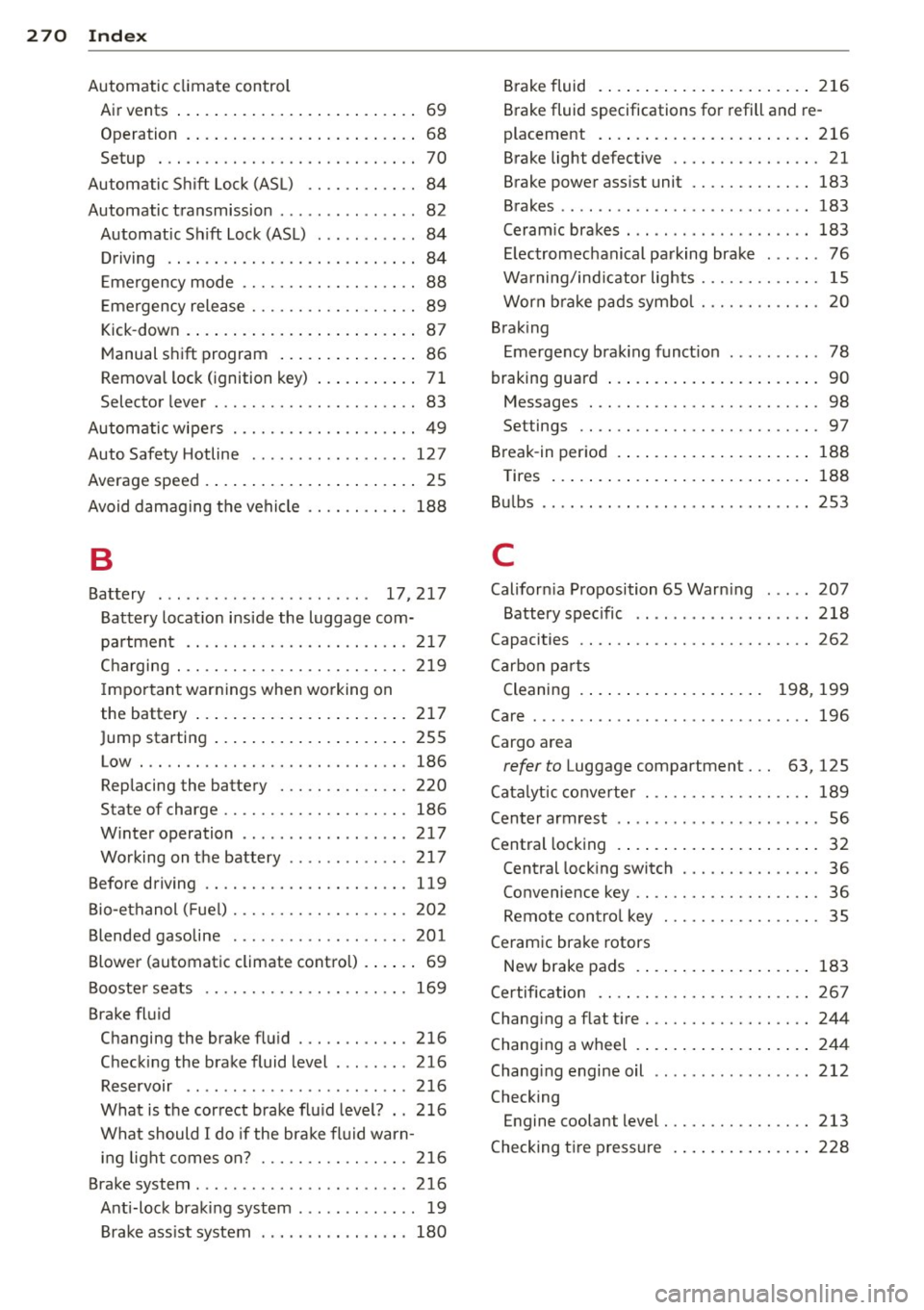
270 Index
Automatic climate control Ai r vents ... ... . ...... ... .. .. .... .. 69
Operation . . . . . . . . . . . . . . . . . . . . . . . . . 68
Setup . .. ............... .. .. .... .. 70
Autom atic S hift Lock (ASL) . . . . . . . . . . . . 8 4
Automatic transmission . . . . . . . . . . . . . . . 82
Automatic Sh ift Lock (ASL) . . . . . . . . . . . 84
D riving .. ... ............ .. .. .. .. .. 84
E mergency mode . . . . . . . . . . . . . . . . . . . 8 8
E mergency release . . . . . . . . . . . . . . . . . . 89
K ick -dow n . . . . . . . . . . . . . . . . . . . . . . . . . 87
M anual s hift program ... .. .. .... .. . . 86
Remova l lock (ignition key) ... .. .... . . 71
Selector lever . . . . . . . . . . . . . . . . . . . . . . 83
Autom atic wi pers .......... .... .... .. 49
Auto Safety Hotline ............ .. ... 127
Average speed . . . . . . . . . . . . . . . . . . . . . . . 2S
Avoid damaging the vehicle .. .... .... . 188
B
Battery ... .. ...... ............ 17,217
B attery locat io n in side the luggage com-
pa rtment ................. .. .... . 217
C ha rging . ............... .. .. .... . 219
I mpor tan t war nings when wo rking on
the battery . . . . . . . . . . . . . . . . . . . . . . . 217
Jump starting .. .. ..... ... .. .. .... . 255
Low . .. .. .. ............. .. .. .. ... 186
Replacing the battery ..... .. .. .. .. . 220
State of charge . . . . . . . . . . . . . . . . . . . . 186
W inter operation . . . . . . . . . . . . . . . . . . 217
Wo rking on the battery . . . . . . . . . . . . . 217
Before driving .. ........... .. .. .... . 119
B io-e thanol ( Fue l) .......... .. .. .. .. . 202
Blended gasoline ... ... .. .. .. .. .. .. . 201
Blower (automatic climate control) . . . . . . 69
B ooste r seats ............. .. .. .. .. . 169
Brake fl uid
C hanging the brake fl uid ..... .. .... . 216
Check ing the brake fluid level ..... .. . 216
Reservoir .. .......... ...... ... .. . 216
What is the cor rect brake fl uid leve l? .. 2 16
What should I do if the bra ke flui d warn-
i ng light comes on? ....... .. .. .. .. . 216
Brake system .... ... .... ... .. .. .. .. . 216
Anti-lock braking system ....... .. .... 19
B rake ass ist system ..... .. .. .. .. .. . 180 B
rake fluid .... .. ... .. ..... ... .. .. 216
B rake fluid specifications for refill and re-
placement . ... .. ... .. ..... ... .. .. 216
Brake light defective ........... .... . 21
B rake power ass ist unit ......... .... 183
Brakes ....... ... .. .............. . 183
Ceram ic brakes ... ... .. .. ... ..... .. 183
El ectromechanical pa rking brak e ..... . 76
Wa rning/ind icator lights ...... .. .. .. . 15
Worn b rake pads symbo l ........ .. .. . 20
B rak ing
E mergency brak ing funct ion ... .. .. .. . 78
braking guard ..... ... .. ..... .... . .. . 90
Messages . .. .. .. .. ........... .... . 98
Settings .. .... .. ............. .... . 97
Break-in per iod .... .. ... ..... ... .. .. 188
T ires ... .. .... .. .. ... ..... ... .. .. 188
Bul bs .. .. .. .. .. .. .. .. ...... ... .. .. 253
C
Californ ia Proposition 65 Warn ing .... . 207
Battery specific .. ..... ........... . 218
Capacities .. .... .. ............. .... 262
Carbon p arts
Cleaning . . . . . . . . . . . . . . . . . . . . 198, 199
Care ........ ... .. .. ... ........... . 196
Cargo area
refer to Luggage compartment. . . 63, 125
Ca talyt ic co nve rter . . . . . . . . . . . . . . . . . . 189
Center armrest .. .. ................ .. 56
Central locking .... ... .. ..... .... . .. . 32
Central lock ing switch .......... .. .. . 36
Convenience key . . . . . . . . . . . . . . . . . . . . 36
Remote contro l key .............. .. . 35
Ceramic brake rotors New brake pads . ... .... .... ... .. .. 183
Ce rtifi cation .. .. .. ... .......... .. .. 267
Chang ing a f lat t ire . ............. .... 244
Chang ing a wheel . ... .... .... ... .. .. 244
Chang ing engine oil ..... .. ... ..... .. 212
Checking Engine coolant level . ........... .. .. 213
Checking t ire press ure . ... .... ... .. .. 228